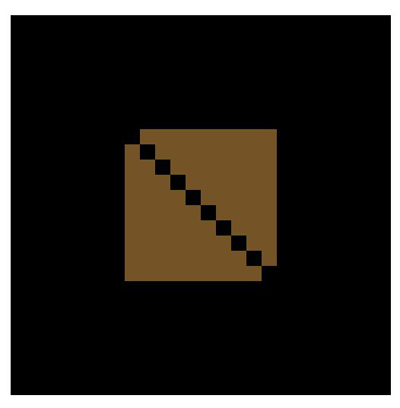Maison >interface Web >js tutoriel >Comment supprimer une zone de bloc en JavaScript html5 Canvas_Javascript Skills
Comment supprimer une zone de bloc en JavaScript html5 Canvas_Javascript Skills
- WBOYoriginal
- 2016-05-16 15:18:031671parcourir
L'exemple de cet article décrit comment supprimer une zone de bloc dans le canevas html5. Partagez-le avec tout le monde pour votre référence, les détails sont les suivants :
La capture d'écran de l'effet en cours d'exécution est la suivante :

Pièce jointe : Sur la photo, le petit carré noir est la zone de bloc supprimée
Le code spécifique est le suivant :
index.html:
<!DOCTYPE html>
<html>
<head>
<meta http-equiv="Content-type" content="text/html;charset=UTF-8" />
<title>canvas中删除一块区域</title>
<style type="text/css">
#canvas {
background:black; margin-top:100px; margin-left:200px;
}
</style>
</head>
<body>
<canvas id="canvas" width="500px" height="500px" ></canvas>
</body>
<script type="text/javascript" src="canvas.js"></script>
<script type="text/javascript">
cache = {};
var offsetX = 50,
offsetY = 20;
cache.context = dyl.createContext('canvas');
dyl.rect(dyl.createColor(), 150, 150, 200, 200, 0.5);
for(var i=0; i<10; i++) {
dyl.clearRect(150 + i*20, 150 + i*20, 20, 20);
}
</script>
</html>
canvas.js :
(function() {
var dyl = {cache: {}};
dyl.setContext = function(context) {
dyl.cache._context = context;
return context;
};
dyl.getDom = function(id) {
return document.getElementById(id);
};
dyl._getContext = function() {
return dyl.cache._context;
};
dyl.save = function() {
var context = dyl._getContext();
context ? context.save() : void(0);
};
dyl.restore = function() {
var context = dyl._getContext();
context ? context.restore() : void(0);
};
dyl.createContext = function(canvasID) {
var canvas = this.getDom(canvasID);
if(!canvas) {
return null;
}
return dyl.setContext(canvas.getContext("2d"));
};
dyl.createColor = function() {
var color = "rgb(";
color += Math.round(Math.random()*255);
color += ",";
color += Math.round(Math.random()*255);
color += ",";
color += Math.round(Math.random()*255);
color += ")";
return color;
};
dyl.addImg = function(img, x, y) {
var context = dyl._getContext();
if(!img || !context) {
return;
}
if(typeof img === "string") {
var oImg = new Image();
oImg.src = img;
oImg.onload = function() {
context.drawImage(oImg, x, y);
}
return;
}
context.drawImage(img, x, y);
};
dyl.rect = function(color, x, y, width, height, alpha) {
var context = dyl._getContext();
if(!context) {
return;
}
context.save();
context.fillStyle = color;
context.globalAlpha = alpha ? alpha : 1;
context.fillRect(x, y, width, height);
context.restore();
};
dyl.circle = function(color, x, y, r, alpha) {
var context = dyl._getContext();
context.save();
context.fillStyle = color;
context.beginPath();
context.globalAlpha = alpha ? alpha : 1;
context.arc(x, y, r, 0, 2*Math.PI);
context.fill();
context.stroke();
};
dyl.clearRect = function(x, y, width, height) {
var context = dyl._getContext();
if(!context) {
return;
}
context.clearRect(x, y, width, height);
};
dyl.scale = function(x, y) {
var context = dyl._getContext();
if(!context) {
return;
}
x = x ? x : 1;
y = y ? y : 1;
context.scale(x, y);
};
if(!window.dyl) {
window.dyl = dyl;
}
})();
J'espère que cet article sera utile à tout le monde dans la programmation JavaScript.
Déclaration:
Le contenu de cet article est volontairement contribué par les internautes et les droits d'auteur appartiennent à l'auteur original. Ce site n'assume aucune responsabilité légale correspondante. Si vous trouvez un contenu suspecté de plagiat ou de contrefaçon, veuillez contacter admin@php.cn
Article précédent:Un article pour maîtriser les connaissances communes des compétences RequireJS_javascriptArticle suivant:Un article pour maîtriser les connaissances communes des compétences RequireJS_javascript
Articles Liés
Voir plus- Une analyse approfondie du composant de groupe de liste Bootstrap
- Explication détaillée du currying de la fonction JavaScript
- Exemple complet de génération de mot de passe JS et de détection de force (avec téléchargement du code source de démonstration)
- Angularjs intègre l'interface utilisateur WeChat (weui)
- Comment basculer rapidement entre le chinois traditionnel et le chinois simplifié avec JavaScript et l'astuce permettant aux sites Web de prendre en charge le basculement entre les compétences en chinois simplifié et traditionnel_javascript

